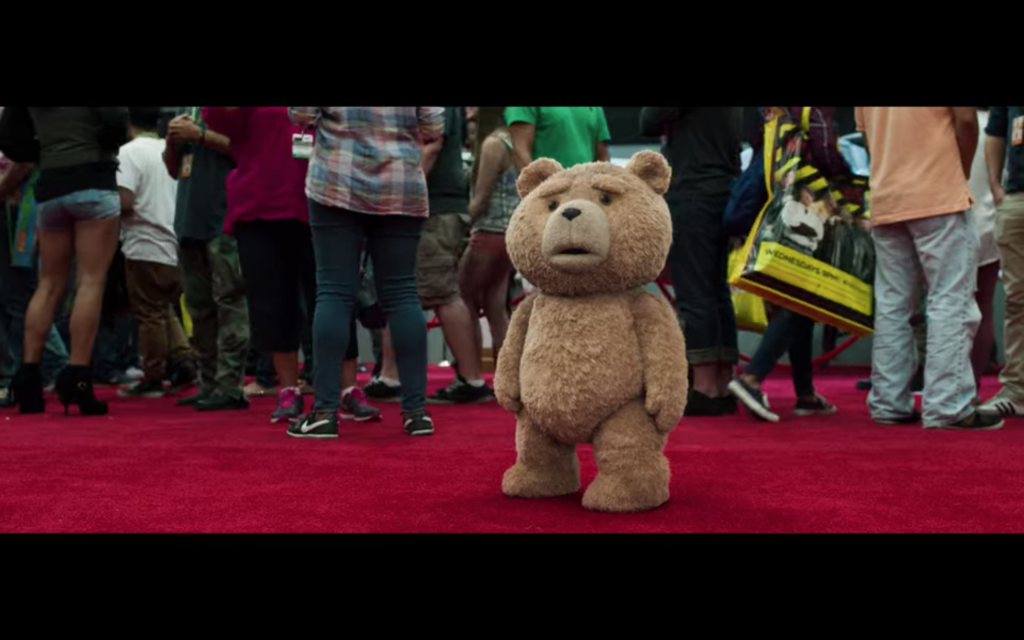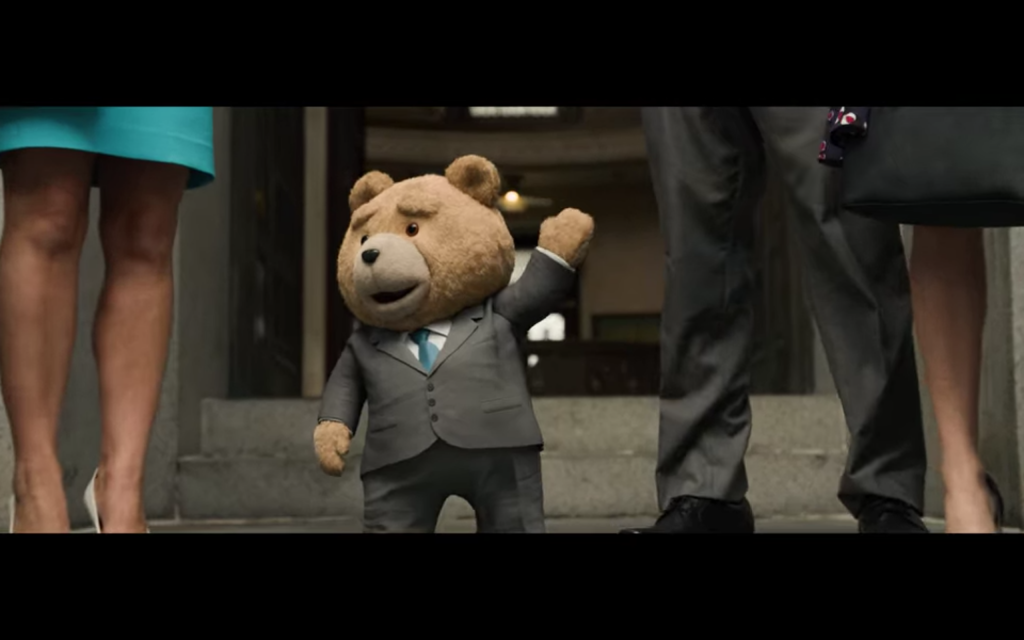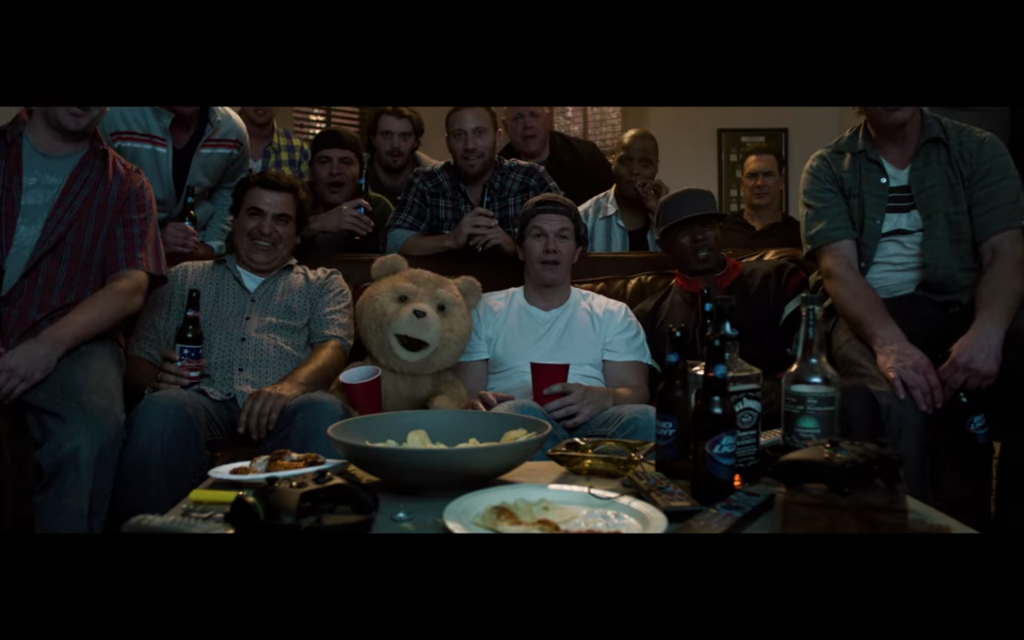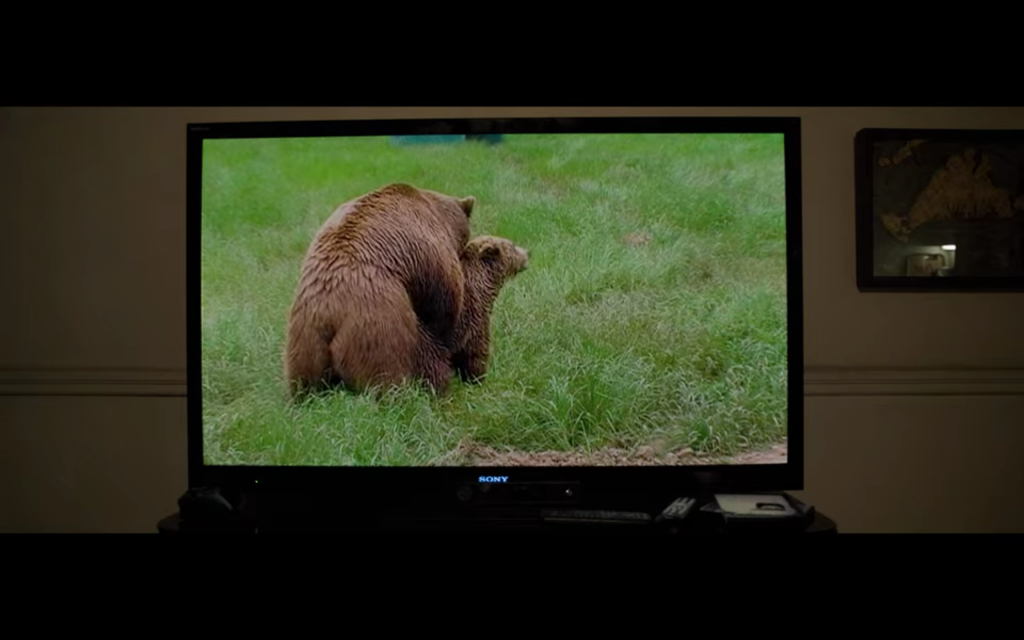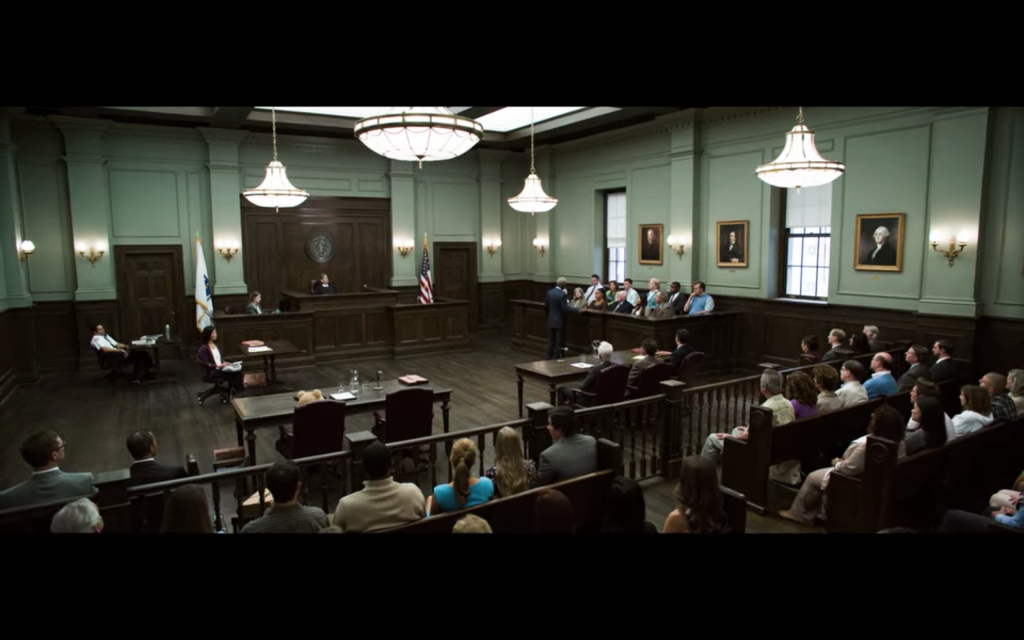Ted 2 is the second instalment of the Ted series in which John (Mark Wahlberg), as a child wishes for his teddy bear, Ted (Seth MacFarlane), to come to life. What follows is thirty-something years of memories, shenanigans and improper behaviour. The first film follows the pair as John finally learns to ‘grow up’. We find them in the second, up to the same tricks, but perhaps with deeper meaning. We find Ted’s Ursine-human marriage to his girlfriend is under pressure as they struggle to adopt a child within the law’s legal scope, as Ted is deemed ‘property’, not human. Throughout the film, we follow Ted and John as they battle for Ted to gain personhood. The film tackles both animal and human rights in the twenty-first-century setting. It Illuminates Ted unique human-ness but also his place within the animal world by blurring the lines in-between. Exploring Ted’s hybrid status or ‘otherness’ leads to issues surrounding human-animal relations both legally and within history.
The creation of Ted is crucial in understanding his place within the film. The teddy bear is quite possibly the ‘evolutionary’ step between the human and the bear. Humans have metaphorically taken the bear and purposefully given it humanistic features; two arms, two legs, paws more like human hands even going so far as to be made to honour a human. Over the decades, this toy has morphed from being a bear, into something altogether more human. Human children grow up with them, name them, talk to them, clothes them. Spiritually, and emotionally, they closely resemble us by our own doing. Ted (Though not so kid-friendly), exemplifies this with his detailed characteristics, behaviours, idioms, and personality. He comes across as less of a bear and more of an unrefined, unfiltered individual.
Ted, as an entity, straddles the line between the human and animal world. The film spends a significant amount of time working to separate Ted from the animal world, while at the same time exemplifying him within it. A notable scene is when the main characters find themselves stuck in the woods. As the scene develops, animals who defiantly do not belong in America’s woods start appearing: a penguin, a monkey, a lobster. While this adds comedic value, Ted is the most interesting ‘animal’ in this scene. Ted does not fit here. As the animals appear, he looks around, confused. It is a brief moment, but it highlights Ted’s exclusivity. He is not in on the joke and lacks understanding, this ‘others’ him from the animals. This ‘othering’ is in many forms throughout the film.
The most obvious being his appearance, he does not look like the other animals. They are live-action, he animation. The difference is evident to the eye; however, it does something more than visually different. Animation is something that belongs solely to the human-world, and Ted is a creation of this. His anthropomorphic features are a product of it. So, while it makes him differ visibly his existence is also different because, on many levels, Ted has been created by humans and therefore exists in the human realm. It is also interesting to note that visually Ted is not like other animals biologically. In animation, animals never have any genitalia, whereas all real animals do. This links back to the fact that animation is a children’s genre, and sexualisation of content for children is immoral. However, this also serves to ‘other’ Ted further. He is not animal or human; his anatomy completely different. It is also important to note that while Ted is an outsider in the animal world, he neither fits into ‘human’. It is most noticeable that Ted does not wear clothes like all humans. Throughout the majority of the film, Ted is ‘naked’. The only thing he wears is his fur. To the audience, this makes him stand out. He is a teddy bear among humans, but the film has established that that is the norm for this world, but because he does not wear clothes like other humans. An action that may make him seem more animal than human, as animals do not wear clothes. The exception to this is what can be considered the high-pressure human moments of the film. The scenes in which some type of humanity is at stake. These are Ted’s marriage and when Ted appears in court. When the film needs to convince the audience that Ted is human more than ever, Ted conforms to a human convention—wearing a suit. The film does all of this to emphasise Ted human-ness. Overall, it seems like the film promotes Ted’s ‘otherness’ for the storyline and then conflicts this by highlighting his human-ness.
The film does not hide away from Ted’s animalism. There is constant rhetoric surrounding his natural origins as an animal. Lines like, “I was able to sniff that out” and in Ted’s wedding scene the traditional line ‘do you take this man’ is now replaced with do you take this ‘teddy bear’. Followed with ‘you may kiss the bride’ is instead ‘you may kiss the bear’. A scene that develops this mix between human/animal rhetoric is in a flashback to Ted’s bachelor party. We see Ted, John, and many other men watching what the viewer would assume is porn. The viewer gets this impression from the generally degrading comments on the female such as, “she’s begging for it” and “she wants it bad.” The shot cuts to the TV, and the viewers see a nature documentary clip in which two bears are mating. Watching these bears as if they are human is potentially problematic. As discussed early, Ted himself lives in the space of in-between-ness. His origin is natural, but the human imagination metaphorically constructs him. He neither belongs to the category of bear or human. So, in this scene, there are multiple levels of complication. Firstly, having human men watch and sexualise these bears creates a strange atmosphere concerning bestiality. That is not to say that any of these characters aspire to have sexual relations with a bear, they do not.
Nevertheless, in using the sexualised rhetoric that usually exists within human sexuality, moral boundaries are crossed, and the wall between human and animal is destabilised. Secondly, as discussed above, Ted is not wholly bear either. It can be ‘normal’ for a species to sexualise one of the same species, for the sake of the argument the men watching human porn would not be altogether atypical. However, Ted exists beyond the realm of the bear, he is not a natural bear, and therefore this scene still holds questionable morality. Further questioning these actions leads to cross-species and identity problems. The morality in question is further called to attention when John says, “You know what’s f**ked up? That’s someone’s f**king daughter.” Applying human standards to these bears exemplifies the degradation that has already occurred.
In a recorded interview Dr Brett Mills, author of Animals on Television: the cultural making of the non-human, explains; “Our contradictory understandings perhaps stem from seeing nature and culture in opposition to one another.”[1] This theory is intriguing when applied to the above argument. If applied to this scene, it invites the possibility that the societal disgust is born form the perceived idea that culture (being cultured) is the direct opposite of nature and by extension, this form of animalism presented in this scene. However, the film itself does influence the perception of human/animal relations—the narrator comments on Ted’s acceptability within human society at the beginning of the film. “A talking teddy bear is about to marry his girlfriend. Proving two things: Happy endings can come true for anyone, and America doesn’t give a s**t about anything.” On the one hand, saying that a happy ending can be true for anyone highlights the message of human-animal rights that the film is promoting. It implies universality and individualism. However, it immediately follows this statement with “and America doesn’t give a s**t about anything.” This statement implies the opposite of what it is saying. In claiming that America (in turn, Americans) do not care about anything implies that they should care about it. It suggests that in reality, this union crosses some cultural appropriateness or social morality.
Looking at the film’s central narrative, it revolves around Ted’s court battle to attain personhood. An inspiration for MacFarlane was the monumental Supreme Court case in the 1850s of Dred Scott.[2] An enslaved African-American who was denied citizenship and was considered legal property of his owner. We can see the similarity is in Ted 2 as the same label threatens the anthropomorphic teddy bear. In comparing this film with its inspiration, it is incomparable to say that a talking bears struggles are the same as that of the enslaved African-Americans and MacFarlane has certainly stretched that too far. However, for this argument, we will separate that disparity and focus on the message individually.
In his book The Law is a White Dog, Colin Dayan writes on the meanings of human and personhood. He writes; “liberal universals are founded on a set of ‘anthropological capacities’ that determine what it means to be human. The ‘anthropological minimum’ for attaining moral personhood is the capacity to reason.”[3] When writing this, Dayan’s topic is enslaved African Americans and what was perceived to be their human characteristics. History has shown that enslaved people were no less human than those who had freedom. However, when this is taken and applied to animals, and in this essay, Ted, it is illuminating. It is quoted that the minimum of personhood is ‘the capacity to reason’, and by connotation to pass judgements and feel emotions. The film proves that Ted, as a being, possesses these qualities. Aside from his human-like appearance, he has many internal qualities. It is discussed above how Ted views other animals and is cognizant that he is different from them. He possesses that logic. He can also use high functioning language, not just basic English, but metaphors and jokes that look at the nature of things. These idioms are often on the offensive side, but again, this shows his understanding of good, bad and the reasoning in-between.
Even if all this were not convincing, recent history has shown that even animals widely classified as animals have joined this argument. In 2015, the Guardian wrote an article focused on a court case for two Chimpanzees who should be released from captivity as they are “self-determining beings.”[4] Steven Wise, the lead attorney, develops this argument by using research on Chimps intelligence and emotional capacities. His thesis is that these beings should not be legally classified as ‘things’ when they are closer to human than ‘animal’. We can again see these similarities in Ted. Classified as property, he is denied his legal rights when all evidence above points to his human-ness. This theory moves past pure anthropomorphism. It associates animal rights, human rights and anthropomorphism altogether. It brings the argument to a place where these concepts are the same. The films high ranking lawyer, Morgan Freeman, exemplifies this further by saying – “once the law devalues one kind of life, how soon before it devalues another? Who gets subjugated after the bear?” This all-encompassing statement reaffirms the stance of the film. That all life is life.
Overall, this film tackles such heavy topics for a comedy about a confusing little teddy bear. It is not hard to say where the film stands in terms of morality as justice is served in the end. However, it is also clear that Ted does not know where he stands in terms of human-ness. It could be argued that even the film does not know where he stands, except that he is not animal. The constant blurring between his animal-ness and human-ness firmly puts him as ‘other’. He is excluded from the animal world, not appearing as other animals do and not in sync with their behaviour. He can never be purely human either, his origins and presentation making it so. The fact that he is a construct of the human imagination also boxes him into a category of ‘thing’ that he can never entirely escape. However, just because he is different, does not make him any less entitled to the rights of a being capable of ‘reasoning’. The film proves throughout that Ted is cable of emotion and logic, even more so for the fact that it is meant to be comedic.
Bibliography:
Alan Yuhas, Chimpanzee representatives argue for animals’ rights in New York court (2015) <https://www.theguardian.com/us-news/2015/may/27/chimpanzee-animals-rights-new-york-court>
Colin Dayan, The Law Is a White Dog: How Legal Rituals Make and Unmake Persons, Princeton University Press, 2011. ProQuest Ebook Central https://ebookcentral.proquest.com/lib/sheffield/detail.action?docID=664593.
History.com Editors, Dred Scott Case (2009/2020) < https://www.history.com/topics/black-history/dred-scott-case>
Tom Jefferys, Representation for Animals – an interview with Brett Mills, (2013), <https://www.wildculture.com/article/representation-animals-interview-dr-brett-mills/1142#>
Further Reading:
Sophie Mayer, Political Animals: The New Feminist Cinema (London: IB Tauris, 2015) see chapter 2.
Paul Wells, The Animated Bestiary: Animals, Cartoons, and Culture (New Brunswick, NJ: Rutgers University Press, 2008)
Lori Gruen, Critical Terms for Animal studies, (University of Chicago Press, 2018)
[1] Tom Jefferys, Representation for Animals – an interview with Brett Mills, (2013), <https://www.wildculture.com/article/representation-animals-interview-dr-brett-mills/1142#> [Accessed 05.01.2021]
[2] History.com Editors, Dred Scott Case (2009/2020) < https://www.history.com/topics/black-history/dred-scott-case> [Accessed 13.01.2021]
[3] Dayan, Colin. The Law Is a White Dog: How Legal Rituals Make and Unmake Persons, Princeton University Press, 2011. ProQuest Ebook Central https://ebookcentral.proquest.com/lib/sheffield/detail.action?docID=664593.
[4] Alan Yuhas, Chimpanzee representatives argue for animals’ rights in New York court (2015) <https://www.theguardian.com/us-news/2015/may/27/chimpanzee-animals-rights-new-york-court> [Accessed 17.12.2020]
